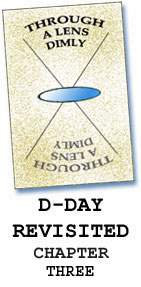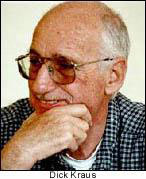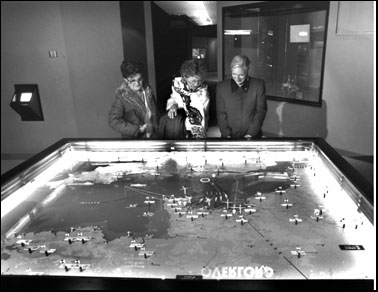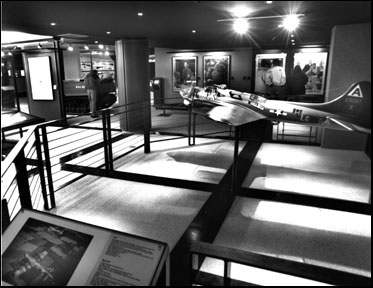PROLOGUE
I was twelve years old when the radio announced that the Allies had
launched the long awaited invasion of Europe that would ultimately
lead to victory and the end of World War II. That day was June 6,
1944 and would come to be known as D-Day.
This June will be the 60th anniversary of that historic event.
I beg your indulgence as I begin the story, about one of the greatest
assignments of my long career as a newspaper photographer.
D-DAY REVISITED
By Dick Kraus
Newsday
Staff Photographer (retired)
CHAPTER THREE
The next
morning found us boarding an express train that would take us through
some of the loveliest European countryside. The train was fast
and comfortable and Kindall and I kind of dozed our way through
the hours, watching picturesque medieval cities, towns and villages
flash past our large window. The train stopped briefly at the French-German
border where we were asked to show passports and travel documents
to the border guards who walked through the train. The landscape
flattened as we sped through the French farmland. In November,
daylight wanes rapidly by three PM in those latitudes. It was dark
by the time we pulled in Caen. We gathered our bags and detrained.
The first thing that we needed to do was rent a car and then go
find a hotel. Well, we found a car rental office right across the
street from the station. We also found that it was closed; not
only for the night, but also for the weekend. It was Saturday and
they wouldn’t open again until Monday. We were supposed to
begin photographing the invasion beaches, the next day. Plus, we
were supposed to meet our German machine gunner, Franz Gockel,
at the American Cemetery in Coleville.
We went back to the station and sat on a bench while we surveyed
our options. We asked a cab driver how much it would cost to take
us to Coleville, the next day. He quoted us a price in francs which
we felt to be pretty expensive. It didn’t matter, though.
We would have paid it except that neither of us had enough francs
to
make the trip. We were still carrying a bunch of German marks,
thinking that we would get a better rate of exchange when we got
to France.
Dumb move. Our next option was to inquire of the man at the ticket
window, if there were trains to Coleville the next day. Fortunately,
there were and we could use our Eurail pass. But, we would have
to take a cab from there to the American Cemetery to meet Gockel.
We
would have just enough francs to make it.
That
having been decided, our next priority was a hotel. Preferably
someplace we could stay for the week and use as a base of
operations. In order to conserve our meager stash of francs,
we opted to walk the couple of miles from the station, to
the outskirts of the city of Caen. I hefted that heavy monster
of a duffel bag onto my shoulder and we proceeded. Aided
by the large maps of the city, mounted on lamp posts every
few blocks, we finally crossed the bridge over the River
Orne and the two of us, tired and bedraggled, entered the
city. From the bridge, I had noticed what appeared to be
a hotel. OK. So the building was outlined in yellow fluorescent
lights and a sign in lights spelled out “Hotel Courtonne.”
I didn’t think that I could take another step with that monster bag on
my shoulder. I even gave it a name. I called it “Monster Bag.”
“ Jim,” I said, “that’s gonna be our headquarters.”
|
© Newsday photo by
Dick Kraus
The Hotel Courtonne at left. |
|
The desk
clerk didn’t speak much English and my high school
French deteriorates as I tire. And, I was tiring fast. But,
we managed to book a couple of rooms for the week.
The place turned out to be an old third class hotel with
tiny rooms. But, our newspaper would be pleased with the
economy
of the place.
It was clean and convenient and anyway, we wouldn’t
be spending much time in the rooms, since we would be ranging
out over the countryside
each day, in pursuit of our stories.
We dumped our bags, washed up and headed out for some dinner.
After walking several blocks, we happened upon a quaint
cobblestone square
that was lined with some interesting restaurants. We
walked around, looking over the menus and prices. Most were
pretty
upscale.
But, what the Hell. We deserved to have a good meal and
we were on expenses.
Besides, look at the money that we were saving the paper
with our hotel.
It was almost 10 PM and I wondered if the restaurants
stayed open that late. I was soon to discover that
Europeans dine
very late.
Most of the restaurants, we were to find, didn’t
even begin to serve dinner before seven or eight PM
and stayed open until well
past midnight.
There were two Moroccan restaurants on the square and
Jim thought one of them would be a good place to
start. He
had never had
Moroccan cuisine. I, on the other hand, was very
familiar with Moroccan
food. My wife, at the time, was from Morocco. She
was an excellent cook
and I knew my way around cous cous with lamb or chicken,
along with any number of other Middle Eastern dishes.
We sat down to enjoy a very tasty meal and then went
back to the hotel to pass out in utter exhaustion.
I was awakened
in
the wee
hours of the morning with terrible stomach cramps.
My exotic Moroccan meal had turned my insides into
a painful,
churning
liquid mess
and I spent several hours on the commode trying
to rid myself of whatever
was causing me such discomfort. I had the runs
for the next few days until one night, when I was on
the phone
to my wife,
I told
her of
my malady. She told me to drink some boiled milk.
Jeez. I remember my mother giving me that whenever
I had
stomach problems as
a child. I hated the taste but it was effective.
The next morning at breakfast
in the hotel, I asked the waiter for boiled milk.
At least that’s
what I thought I was asking for when I requested “latte brouille,
s’il vous plait.” As I said before,
my French leaves a lot to be desired. The waiter
looked at me like I had two heads.
I guess that no one in France asks for their milk
to be scrambled. Eggs, maybe. But not milk. I was
to have these kinds of language
problems all through France. But, I managed to
make my request understood and I got the boiled
milk. By afternoon, my problem was gone.
Anyway, the
morning after the fateful Moroccan meal, with my stomach threatening
to embarrass me at any moment, we hiked back to the railroad station,
traveled to Coleville, took a cab to the American Cemetery and
checked in with the American superintendent of the place
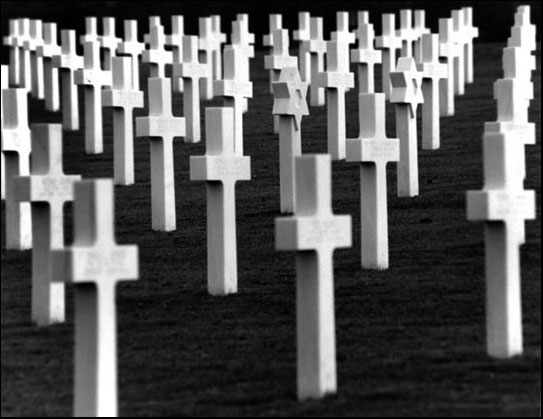
© Newsday Photo by Dick Kraus
Crosses and Stars of David
mark the resting place of thousands of American GI's
at the American Cemetery at Coleville in Normandy. |
|
We were
given a brief history of the cemetery and taken on a tour.
In the weak sunlight of a winter day,
we saw row upon row upon row of simple headstones, marked with
crosses and an occasional Star of David that covered the gentle
rolling ground that was situated on a high cliff that overlooked
the beachhead that was Omaha Beach. |
I took
a few photographs before we were met by Franz Gockel and
his wife. They had driven by car to Normandy from their home
in Germany. We walked outside the gates of the American Cemetery
and Gockel led us across the cliff for another hundred yards
or so. There he pointed out a ditch that had once been a
trench. Carved out of the side of that trench was a dugout,
lined with stones and just discernible through the tangled
growth that had sprung up over the intervening decades. It
offered a clear view of the beach, just below, and Gockel
pointed out that this was his machine gun nest from which
he fired upon the thousands of American GI’s who swarmed
off their landing craft. At least, those who made it past
the shells and the deep water and sandbars offshore. |

© Newsday Photo by Dick Kraus
Franz Gockel stands near
the remains of his machine gun nest from where he fought
the Allies on D-Day in 1944. |
|
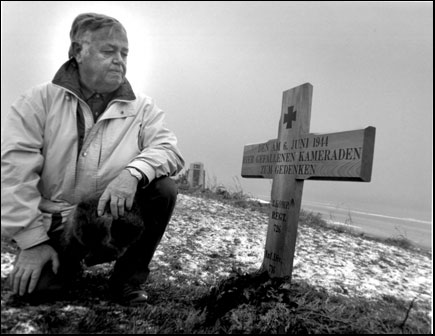
© Newsday Photo by Dick Kraus
Franz Gockel looks at a cross
that he had erected near his machine gun nest, as a
memorial to his fallen comerads. |
|
As Gockel
stood there, remembering the events of 1944, I made photographs
of him from every conceivable angle. These would be better
images and much more relevant than any of the head shots that
I had made of him back at his home. It seemed to me at the
time, looking at the old German veteran, that he was hearing
the sounds of battle and smelling the gunpowder from his gun
as he stood there and relived that cataclysmic day. |
We walked
back to the cemetery parking lot and Franz drove us a few miles
away to
a small, privately
owned
and operated
D-Day
Museum.
It was run by a local farmer who had collected
many artifacts of that battle and had constructed
a small
museum with
dioramas depicting
the scenes of war. Gockel had gotten to
know this Frenchman and his
family and they had become friends. We
were introduced and Kindall interviewed the farmer
and his family,
getting the
perspective
of the French citizens who lived through
those dramatic times. The farmer
had included a diorama of Gockel’s
machine gun nest and there was a wax mannequin
of a German soldier manning a heavy caliber
machine
gun that was supposed to be Gockel.
From
there, we drove further inland to the German military cemetery,
Soldatefriedof, in La Cambe. This is the focus of Gockel’s
yearly pilgrimages to Normandy. It is here that his friends
and comrades in arms lay buried. It is here that he comes to
pay his respects and to lay flowers on graves of those he once
knew.
Here, instead of the simple head markers that we saw at the American Military
Cemetery, massive Teutonic Crosses stand at the heads of groups of graves.
It is a very imposing sight and it made for some very impressive photos.
When we came to a group of graves that marked the final resting place of
some of his comrades, Franz laid flowers at their feet and bent to one
knee to offer a prayer. |

| © Newsday Photo
by Dick Kraus |
|
I tried to keep a respectful distance
so as not to intrude. With long lenses
and
shallow depth
of field,
every angle
from which
I shot made very dramatic pictures.
Still, I knew there was one that
was missing. One that showed the solemnity
of the occasion. I walked around to
the back of
those
large crosses
and I saw, instantly,
what I must do. I didn’t need recognizable photos showing Franz’s
face. I needed a picture that showed an old German soldier; once
an enemy, now just another survivor of a long past war, remembering
his dead friends, just as many American GI’s
were doing at the American cemetery
up the road.
I snapped on my 14mm, ultra wide-angle lens and laid the camera
on the grass. I couldn’t see what I was getting through the
viewfinder. Older versions of the Nikon had removable prisms which,
when removed, allowed you to sight down into the ground glass viewing
screen. Lacking that ability, I could only place the camera where
I estimated the angle that I desired and I shot several frames,
changing the angle slightly each time.
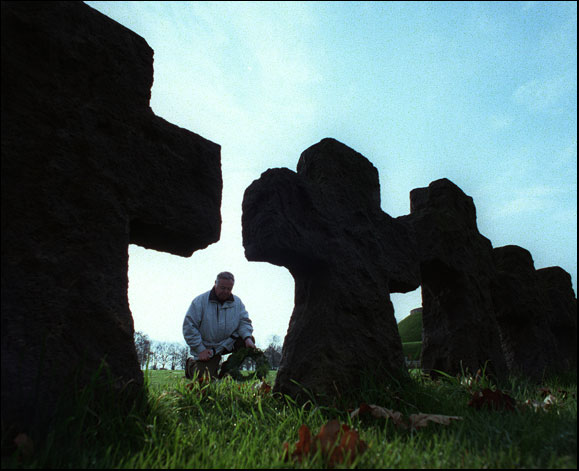
| © Newsday Photo by Dick Kraus |
|
Oh, what I
would have given to have had a digital camera back then. I could have reviewed
my shots on the back screen and made whatever adjustments that were necessary.
It would be another week before I would be back at the paper, developing
my film, before I could see the results. Fortunately, years of experience
had served me well, and I did get what I wanted. And it is one of my most
treasured shots. |
Jim and I
took the Gockels to a lovely restaurant in the countryside for
a delightful dinner.
Thankfully, American
Express was accepted,
because we hadn’t a sou
in French money to our name.
Then
Franz drove us to the railroad
station for our trip back to Caen
As
soon as we got off the train in Caen, we went to the car rental
agency and rented a small Renault. It had a five speed manual
tranny and no power, so I was more than happy to let Kindall
do the driving. And, we also managed to change our money to
francs. Now we were all set. We drove back to the hotel and
parked on the street, as there was no hotel parking.
We had a lot to cover the next day, so we were up early. Our
first stop was at Le Memorial at Caen. This was an extensive
museum devoted to the D-Day landings, located in a modern building
and run as a joint venture by the French and Americans. Kindall
had been in touch with them by mail and by phone and had made
contact with a young American woman who was the Special Events
Coordinator. She was most helpful and showed us around the various
exhibits in the museum. There were so many wonderful displays,
from a large scale diorama showing model landing craft coming
ashore on the beaches and the opposition forces arrayed against
them, to cutaways of a B-17 Flying Fortress heavy bomber. I had
my work cut out for me, trying to decide which things to photograph
and which to omit. There was just so much that it became overwhelming
and I knew that I’d be lucky if one or two of these made
the final cut in the paper.
After a few hours, we hit the road and Kindall maneuvered our
little car through the city traffic and out into the Norman countryside,
on our way to look over the landing zone at Utah Beach. The roads
were narrow and the countryside was beautiful as we headed north. |
|
|

© Newsday Photos by Dick Kraus
Views of Le Memorial in Caen.
|
|
As we approached the shore,
there were areas that still displayed the fury of the allied landings
in 1944. There were stretches of real estate just inland from the
beach where the German Army had constructed fortifications and
pillboxes of thick, re-enforced concrete. Many of these were still
in evidence; some blasted apart by high explosive ordinance from
allied ships and planes. The surrounding area was pocked with huge
craters and the landscape resembled the surface of the moon.
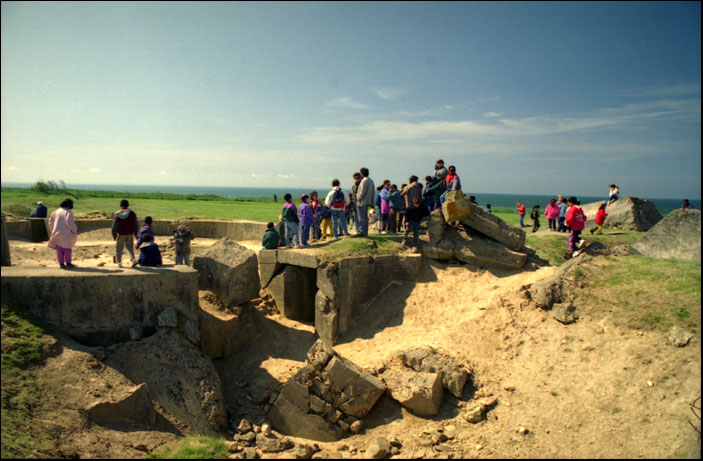
© Newsday Photo by Dick Kraus
French Schoolchildren climb
over the blasted remains of German fortifications that
failed to fend off the Allied troops coming ashore
at Pte. Du Hoc on the Normandy coast. |
|
Many of the pillboxes
still contained the large coastal guns that had once wreaked havoc
upon the ships and landing craft. I was amazed at how well those
weapons had withstood the corrosive power of the dampness and the
salt laden air along the seacoast. I climbed around those bunkers
and over the cannon and to my eye, it looked as though the guns
were still operable. Even though there had been no maintenance
performed on them for fifty years, you might possibly load them
with powder and shell and fire them off, probably to the detriment
of the French and English fishing fleets that still ply their trade
in those waters. There were signs in several languages, warning
of unexploded shells, still buried in the sand where they have
lain for all these years.

© Newsday Photo by Dick Kraus
One of the German coastal
guns that escaped the Allied bombardment on D-Day, still
stands, guarding the Normandy coastline at Longues
sur Mer. |
|
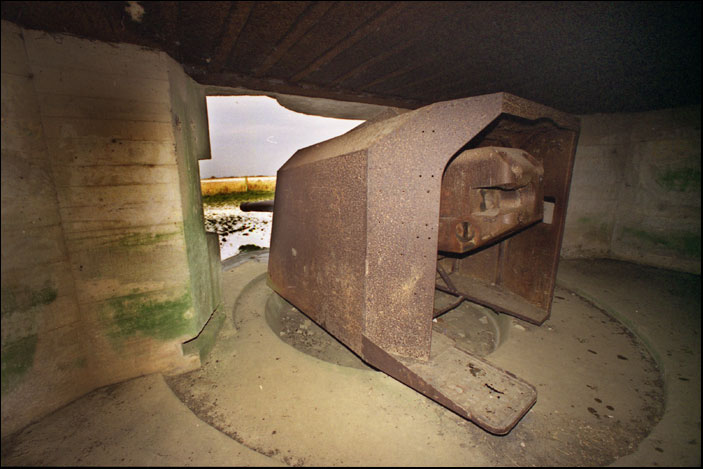
© Newsday Photo by Dick Kraus
Inside the German gun emplacement at Longues sur Mer, The
coastal gun stands as it did 50 years ago on D-Day,
without a hint of deterioration.
|
|

© Newsday Photo by Dick Kraus
Newsday writer Jim Kindall looks across the water at the
high, steep cliffs of Pte. Du Hoc where Len Lomell
and his fellow Rangers scaled to the top on D-Day. |
|
On a
high promontory, overlooking the English Channel, was Pte.
Du Hoc, This is where the American Rangers scaled the cliffs
to eliminate those German 155 mm coastal guns about which we
were told when we interviewed Len Lomell back in New Jersey
a few weeks ago. Hearing him narrate the story of those brave
GI’s hauling themselves up the ropes along the vertical
face of those stone cliffs under withering small arms fire
was dramatic enough. But seeing those imposing sheer walls
in person brought the immensity of the task into perspective
and as I photographed the area, I had a sudden sense of humility
in the knowledge of the bravery of those gallant men. |
| There
are many memorials all over Normandy, dedicated to different
units who fought on D-Day and the days following. None is more
imposing than the rather phallic looking concrete obelisk that
rises above the spot where the battle took place at Pte. Du
Hoc. |
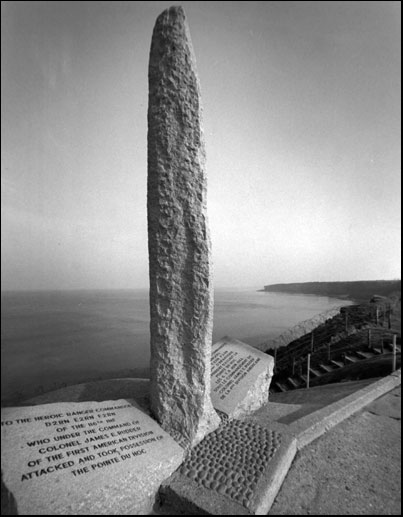
© Newsday Photo by Dick Kraus
The Memorial atop of Pte. Du Hoc, dedicated to the American
Rangers who scaled the cliffs and fought and died on
D-Day. |
|
In contrast to
the noise and
death that occurred
there
in June of
1944,
on this winter day
in 1993,
there was a stillness
and serenity
that
seemed oddly out of place, given the
nature
of our assignment. In
the fading
light
of a winter day,
trainers
from
a nearby racetrack
were working out their horses
and sulkies
on the
hard packed sand.
Long gone were
the tracks
of tanks and amphibious
vehicles
and the boot prints of
soldiers.
And, the
bloodstains
in the sand.
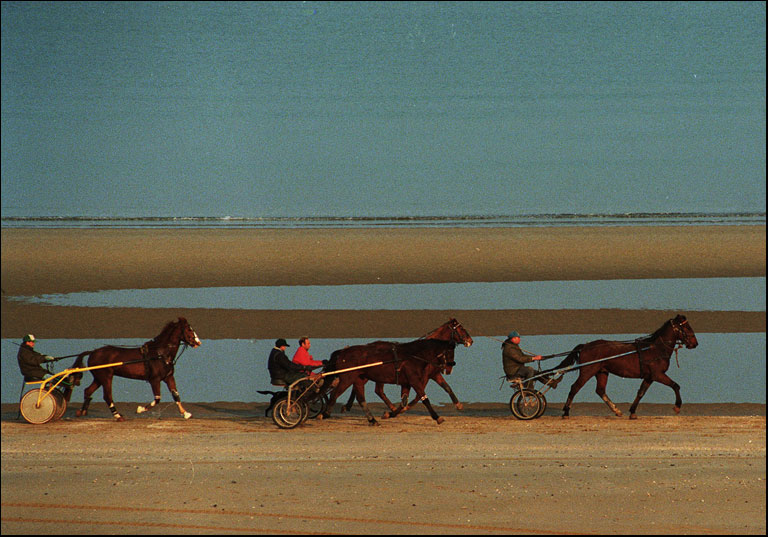
© Newsday Photo by Dick Kraus
Trainers from a nearby race track, work out their trotters
on the hard packed sand of what had been Utah Beach. |
|
CHAPTER FOUR COMING NEXT MONTH
newspix@optonline.net
http://www.newsday.com
|
